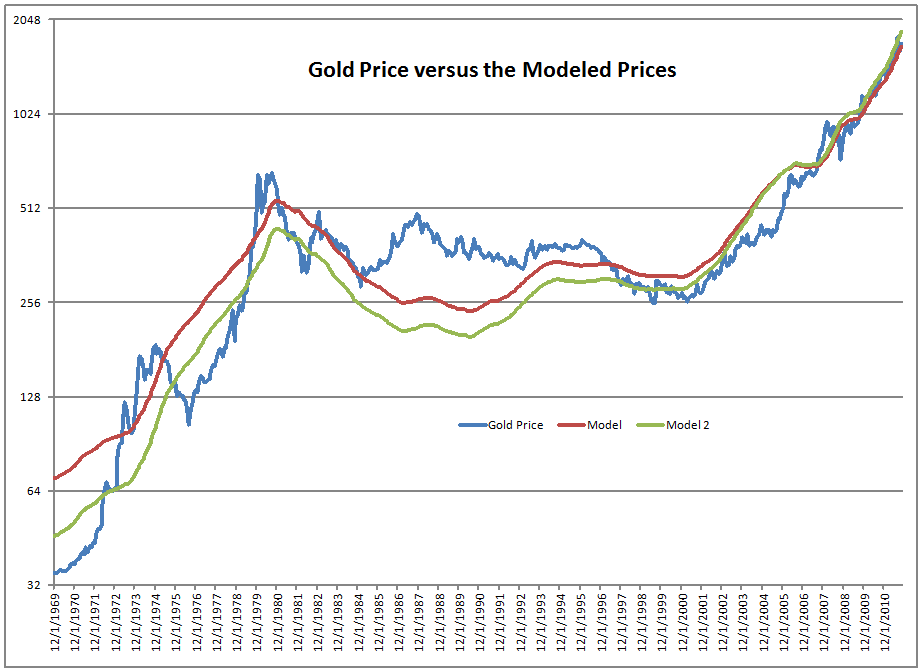Eddy Elfenbein is a clever guy; he put together a model of gold prices that fits the data very well.? Tonight, I will share my own variation on the model, and try to give an intuitive explanation of why it works.
Ask yourself this: where does investor put his money if he wants to stay safe?? Most people are savers not investors, so ideally they would want to put their money on deposit and earn a real return with the ability to access their money at any time.? Then there is the alternative asset, gold.? Gold is a hedge against inflation, but it throws off no interest.? But at some level of real return, savers begin to conclude that they aren’t earning all that much, so they may as well hold gold.? Vice versa when real rates rise.
One more thing: gold doesn’t benefit from productivity increases, as stocks do.? Rapidly increasing productivity makes gold less attractive than stocks.
Eddy’s model boils down to this (in my implementation):
Percentage change in gold price = Multiplier * Percentage change in (Deflator Index / Real return Index)
where the Real Return index compounds three month T-bill yields less inflation via the 12-month CPI-U in arrears.
Here is how well the mode works, since 1970:
The first model attempts to minimize absolute dollar price differences between actual and model.? The second attempts to minimize the ratio between actual and model prices.? Both have R-squareds over 90%.
The deflator return is constant in percentage terms.? For the two models it is around 2.3%/yr, which is not far from productivity gains.
As for the multiplier, it is near six.? The multiplier is like a duration figure with bonds.? What this means is that the percentage change in real interest rates, three-month T-bills less CPI-U inflation, is projected to persist for six years.? Six years is a reasonable figure, because monetary policy changes slowly, but not glacially.
Now, at present levels of real interest rates, with T-bill yields near zero, and the CPI above 3%, it implies a gold price rising at 3% per month.? If inflation stays where it is and the Fed holds good on its promises, that means a gold price in the $3000s in mid-2013.
Do I believe this?? Partially.? I own lots of oil stocks, but nothing in metals at all.
Eddy’s model helps to clarify the value of gold.? It is a store of value, as its price anticipates the degradation and strengthening of the dollar, because changes in real rates will persist on average for six years.


Adjusted model:
http://www.bigtrends.com/etf/goldratesinflation-model-forecasts-gold-4400-by-2014/?utm_source=DTW&utm_medium=email&utm_aacterm=FA&utm_content=L+1&utm_campaign=DTWL
Better model or overfit?
It’s really the same model. Eddy lined it up by sight. The guy at bigtrends used simulation to come up with his results. I used nonlinear optimization. There are only three variables in the model — initial gold price, the deflator (productivity increase, I think), and the multiplier (duration of policy impact).
Another difference was data periods and sources. Eddy’s was shortest. I used data from the World Gold Council, and FRED.
The biggest differences are those of interpretation. Eddy and I are agnostic on the future price of gold, whereas the other guy is a gold bull.
BTW, the idea of the deflator as being driven by anticipated productivity helps explain why the model mistracks in the 70s, when productivity sagged. Allowing the deflator to vary with productivity could be a model enhancement.